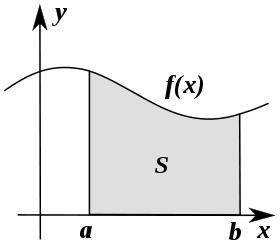Functional (mathematics)


In mathematics, and particularly in functional analysis and the calculus of variations, a functional is a function from a vector space into its underlying field of scalars. Commonly the vector space is a space of functions; thus the functional takes a function for its input argument, then it is sometimes considered a function of a function (a higher-order function). Its use originates in the calculus of variations, where one searches for a function that minimizes a given functional. A particularly important application in physics is searching for a state of a system that minimizes the energy functional.
Functional details
Duality
The mapping
is a function, where x0 is an argument of a function f. At the same time, the mapping of a function to the value of the function at a point
is a functional; here, x0 is a parameter.
Provided that f is a linear function from a linear vector space to the underlying scalar field, the above linear maps are dual to each other, and in functional analysis both are called linear functionals.
Definite integral
Integrals such as
form a special class of functionals. They map a function f into a real number, provided that H is real-valued. Examples include
- the area underneath the graph of a positive function f
- Lp norm of functions
- the arclength of a curve in 2-dimensional Euclidean space
Vector scalar product
Given any vector in a vector space , the scalar product with another vector , denoted or , is a scalar. The set of vectors such that is zero is a vector subspace of , called the null space or kernel of .
Locality
If a functional's value can be computed for small segments of the input curve and then summed to find the total value, the functional is called local. Otherwise it is called non-local. For example:
is local while
is non-local. This occurs commonly when integrals occur separately in the numerator and denominator of an equation such as in calculations of center of mass.
Functional equation
The traditional usage also applies when one talks about a functional equation, meaning an equation between functionals: an equation F = G between functionals can be read as an 'equation to solve', with solutions being themselves functions. In such equations there may be several sets of variable unknowns, like when it is said that an additive function f is one satisfying the functional equation
Functional derivative and functional integration
Functional derivatives are used in Lagrangian mechanics. They are derivatives of functionals: i.e. they carry information on how a functional changes when the input function changes by a small amount.
Richard Feynman used functional integrals as the central idea in his sum over the histories formulation of quantum mechanics. This usage implies an integral taken over some function space.
See also
References
- Hazewinkel, Michiel, ed. (2001), "Functional", Encyclopedia of Mathematics, Springer, ISBN 978-1-55608-010-4
- Rowland, Todd. "Functional". MathWorld.
- Lang, Serge (2002), "III. Modules, §6. The dual space and dual module", Algebra, Graduate Texts in Mathematics, 211 (Revised third ed.), New York: Springer-Verlag, pp. 142–146, ISBN 978-0-387-95385-4, Zbl 0984.00001, MR 1878556